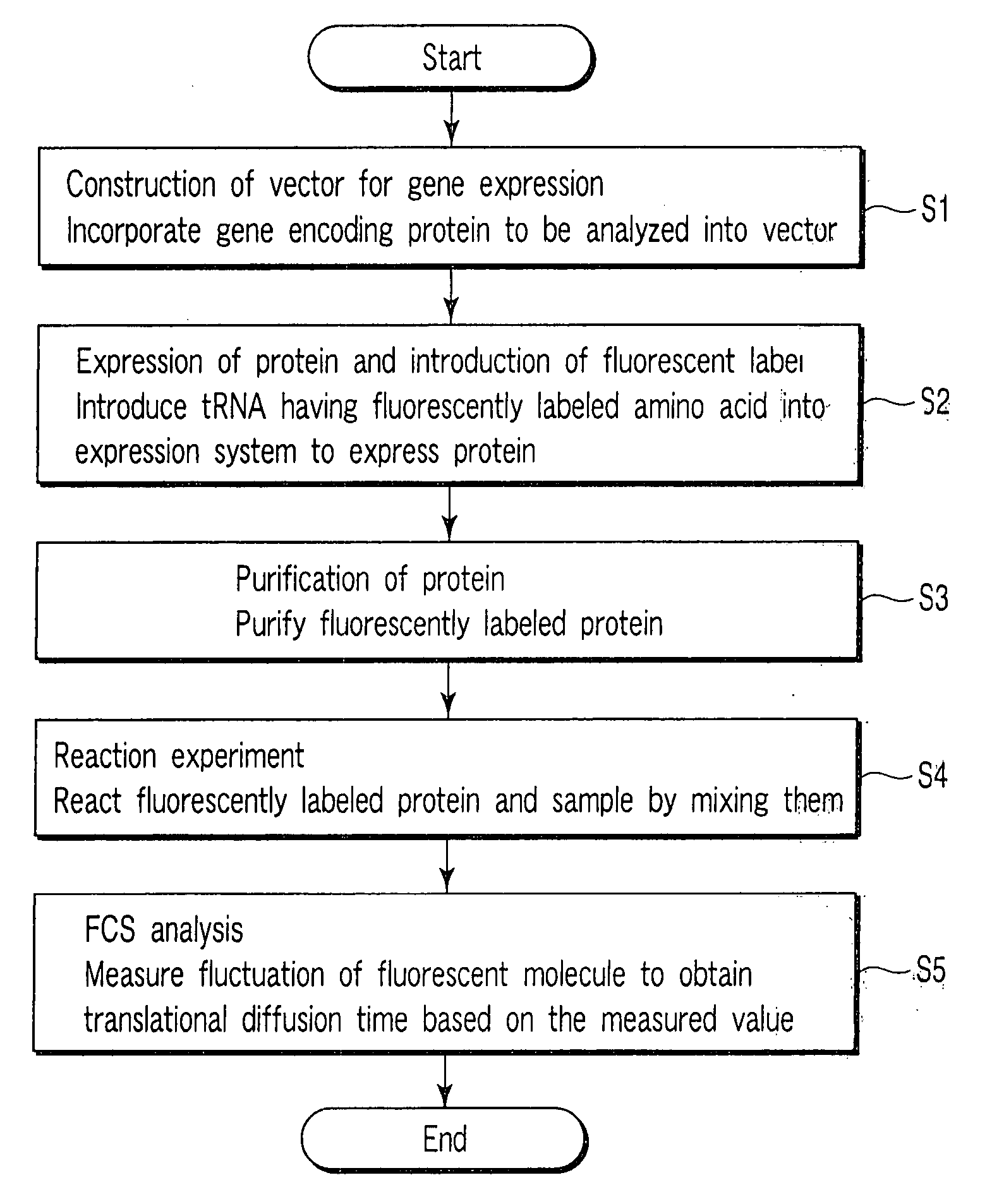[0014] An object of the present invention is to provide a method for detecting a reaction of a fluorescently labeled protein and a sample, simply, in a short time and at a higher precision.
[0016] According to this feature, a protein can be fluorescently labeled without incorporating a large substance other than the protein or chemically modifying the protein, and therefore a reaction experiment can be performed while the original function of a protein is maintained, and the size, brightness or count of a substance having a fluorescent
label can be obtained by mixing of each solution and using a
fluorescence analysis method. Therefore, the detection result such as the presence or absence of a reaction, and change in the size, brightness, and number of protein can be obtained simply, in a short time and at a higher precision, without a troublesome procedure such as utilization of a radioisotope,
electrophoresis, work of immobilizing a molecule on a
solid substrate, and washing work.
[0017] Particularly, a reaction experiment can be performed in a homogeneous system in which a protein and a reactive substance are reacted with each other in a solution while being mixed, therefore transfer of a
reagent can be automated, and reactors having a variety of forms can be used. Further, since a lot of samples can be handled on microplate at once, analysis can be performed countably, continuously, simply, in a short time and at a higher precision. In addition, since a
solid support is not used, even a protein which is difficult to be
solid-phased can be reacted and analyzed.
[0020] According to this feature, a protein can be fluorescently labeled without introducing a large substance into the protein or chemically modifying the protein, a reaction experiment can be performed while the native function of the protein is maintained, and the size, brightness or count of a substance having a fluorescent
label can be obtained by mixing of each solution and using a
fluorescence analysis. Therefore, the detection result such as the presence or absence of a reaction, change in the size, brightness, or number of a protein, and promotion or inhibition of, or absence of influence on, a reaction by a substance reacting with a protein can be obtained simply, in a short time and at a higher precision, without a troublesome procedure such as utilization of a radioisotope,
electrophoresis, immobilization of a molecule on a
solid substrate, and washing work.
[0027] According to this feature, a protein can be fluorescently labeled without making a protein incorporate a large substance other than the protein or chemically modifying the protein, a reaction experiment can be performed while the original function of a protein is maintained, and the size, brightness or count of a substance having a fluorescent
label can be obtained by mixing of each solution and utilizing
fluorescence analysis. Therefore, the detection result such as the presence or absence of a reaction, change in the size, brightness, or number of a protein, and promotion or inhibition of, or absence of influence on, a reaction by a substance reacting with the protein can be obtained simply, in a short time and at a higher precision, without a troublesome procedure such as utilization of a radioisotope,
electrophoresis, work of immobilizing a molecule on a
solid substrate, and washing work.
[0028] According to the present invention, a reaction experiment can be performed while the original function of a protein is remain unchanged, and the detection result such as the presence or absence of a reaction, change in the size, brightness, or number of a protein can be obtained simply, in a short time and at a higher precision, without a troublesome procedure such as utilization of a radioisotope, electrophoresis, work of immobilizing a molecule on a
solid substrate, and washing work.
 Login to View More
Login to View More 

